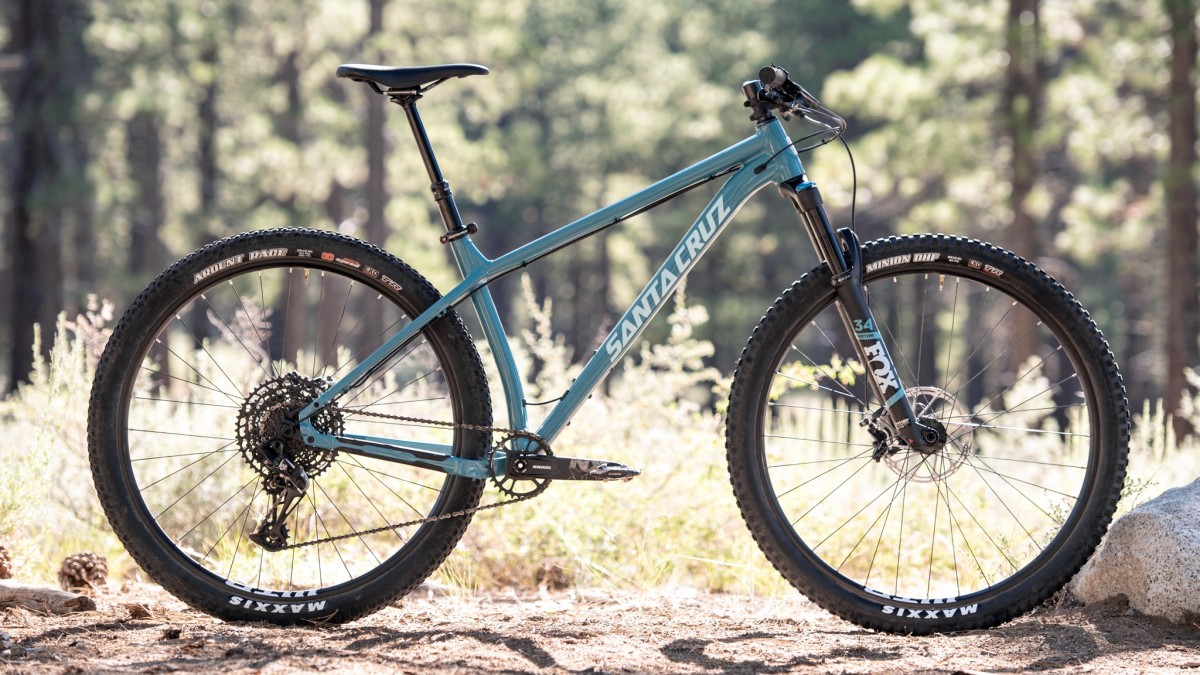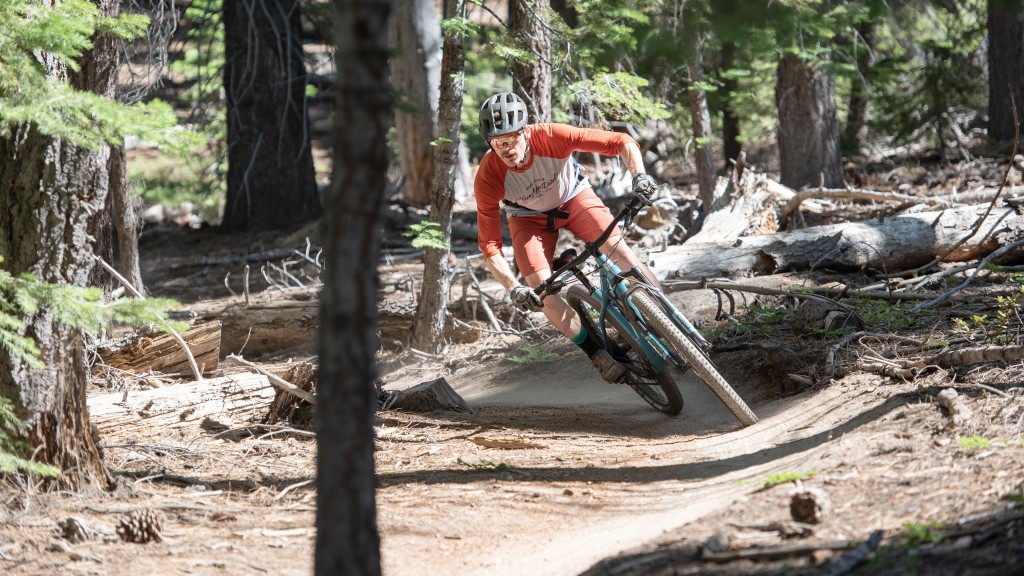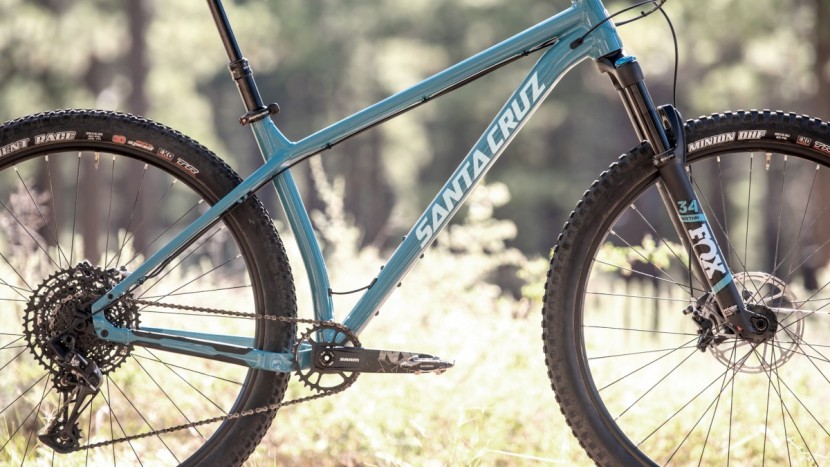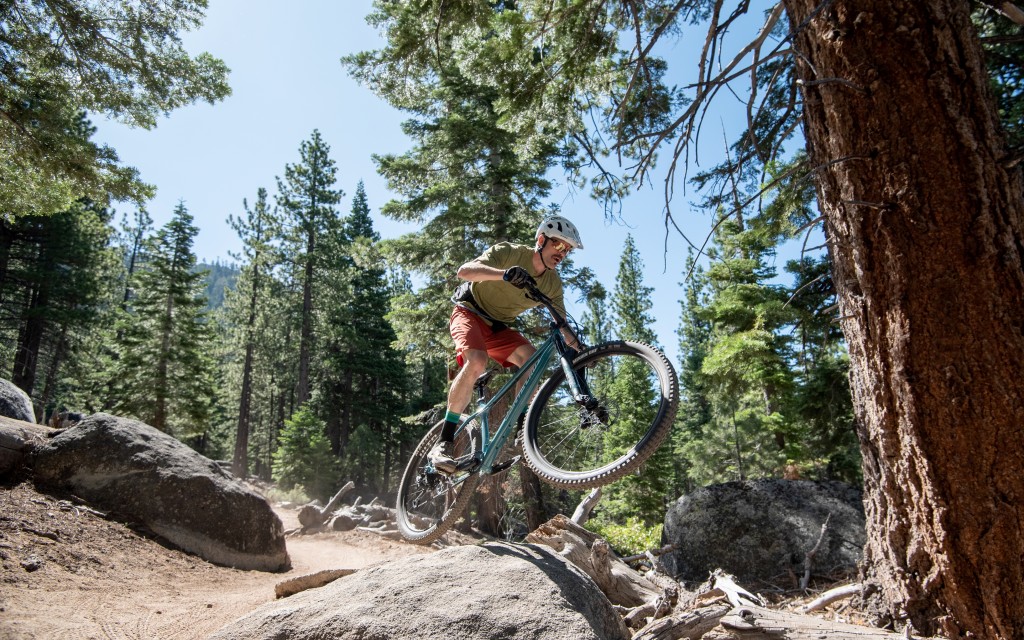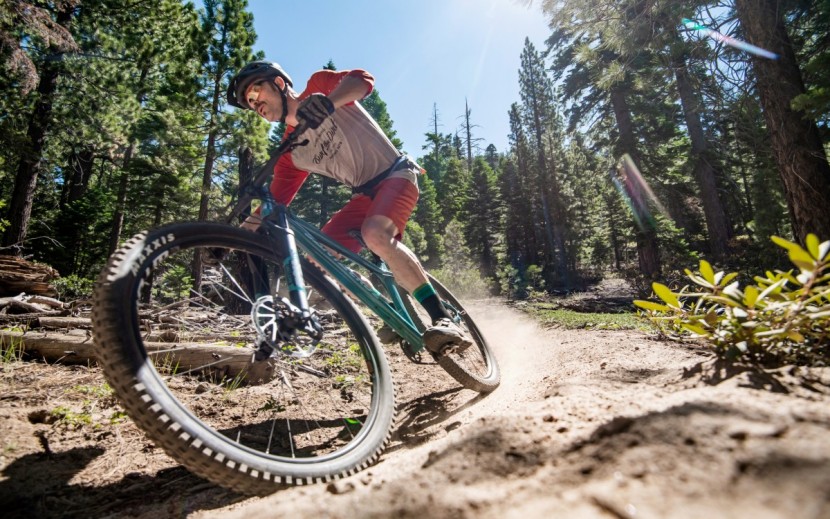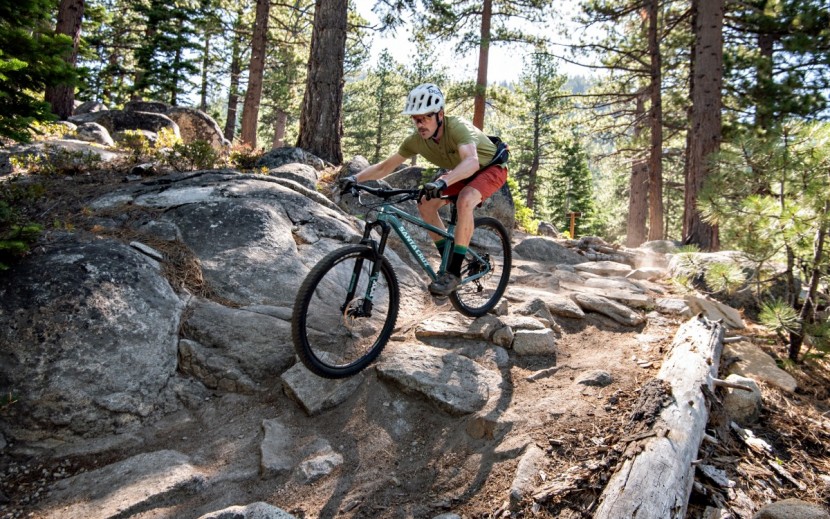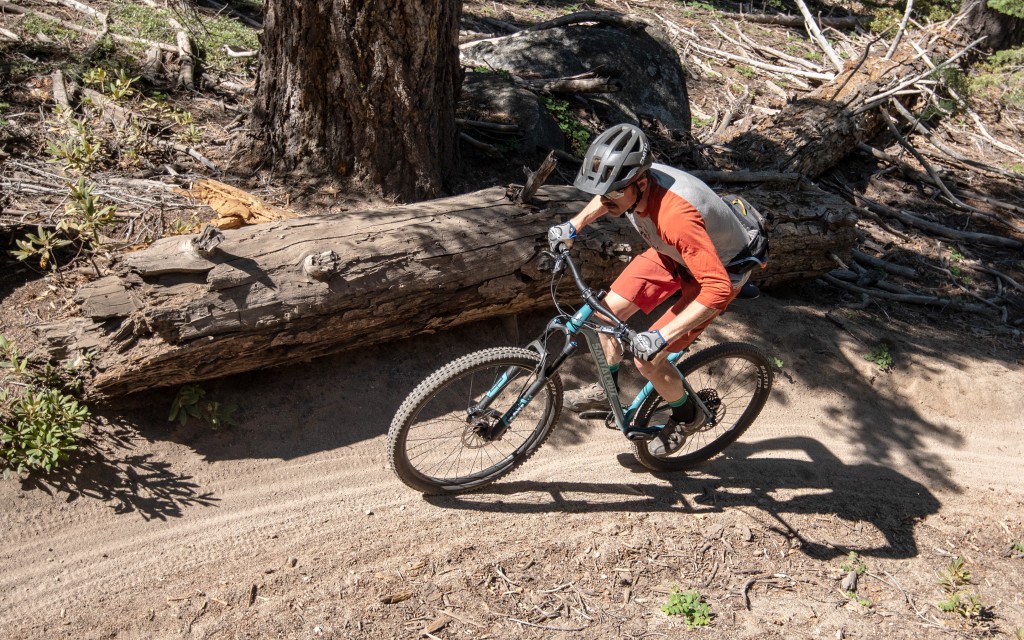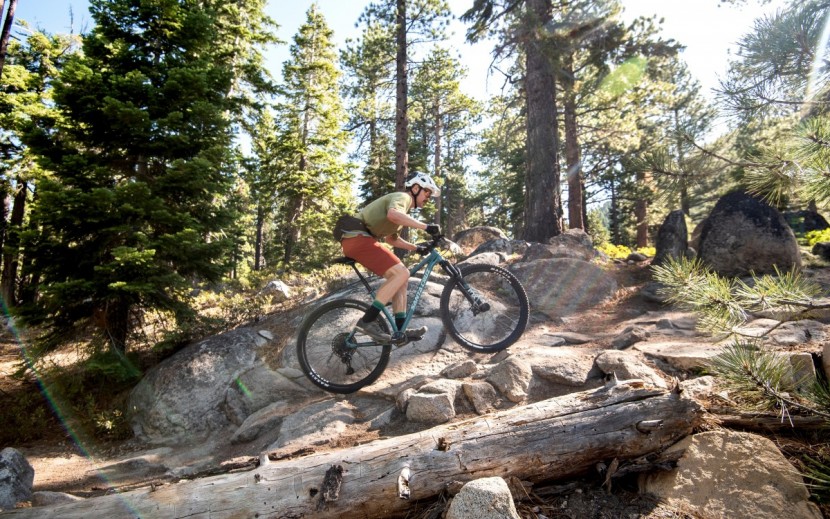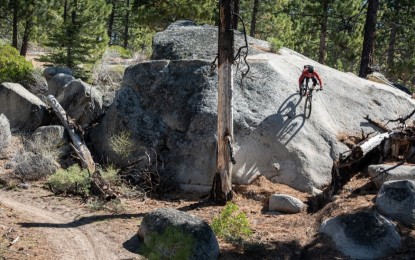Santa Cruz Chameleon 29 R Review
Our Verdict
Our Analysis and Test Results
Should I Buy This Bike?
The Chameleon is an excellent choice for those who want a supremely fun and adjustable hardtail mountain bike. This bike can run 27.5+, 29er, a geared drivetrain, a single-speed drivetrain, and offers two chainstay lengths. In other words, there are a lot of options. The Chameleon earned a Top Pick for Fun-Loving Riders. There are better options for the cross-country application, and there are also better options for charging hard. There are also better options for riders seeking a hardtail to serve as a one-bike quiver. That said, this bicycle is supremely fun and is a great choice for the rider who wants a hardtail to slap corners and play around. At $2,399, this bike delivers a solid value from a premium brand that is viable for the masses.
Those seeking a hardtail to serve as a daily-driver will love the Editor's Choice Specialized Fuse Expert 29. The Fuse is a jack-of-all-trades and beautifully blends a high-fun factor with killer downhill performance and solid climbing abilities. This bike runs meaty 29 x 2.6-inch tires and is exceptionally confident at high speeds and delivers great cornering abilities that inspire you to push hard into the bends. The ride is reasonably compliant over chop and has a bit more of a comfortable feel compared to the Chameleon. Climbing is also quite impressive and the Fuse has a steeper seat tube angle and a longer reach compared to the Chameleon. While the Fuse Expert 29 is a touch less expensive, the Chameleon has a significantly better fork specification.
If you want a hardtail for trail riding and cross country racing, the Ibis DV9 is a no-brainer. This carbon hardtail mountain bike delivers breezy climbing performance and sharp handling given its efficiency-focused, conservative, geometry. Are you looking for a bike to knock out full-day rides? This is it. Want to enter the occasional cross-country race? This is your bike. Downhill performance is solid, and this bicycle relies on quick handling to navigate through tech. That said, the carbon frame is not as compliant when charging over the rough stuff. The Chameleon produces a more fun-filled ride and has the edge on technical downhills while the DV9 is much lighter, more efficient, and has a zippier feel. This bicycle is available in carbon fiber only with build kits starting at $2,550 (tested).
If you fancy a hardtail but prefer flying downhill, we tested a couple of hardcore hardtails that would fit the bill. The Rocky Mountain Grolwer 50 and Commencal Meta HT AM are downhill destroyers. These bikes offer enduro-style geometry on a hardtail mountain bike. Both of these rigs are crazy stable at speed and don't shy away from the rough stuff. Given their downhill dominance, climbing was clearly not a priority in the design process. They can get up any hill, but these bikes cannot match the efficiency of the rest of our test class. The Growler 50 is our Top Pick as Best Aggressive Hardtail and it retails for an eye-popping $1,899.
Frame Design
The Chameleon has a clean-looking aluminum frame. As of 2019, this bike is also available in carbon fiber in addition to aluminum. It can run 29-inch (tested) wheels or 27.5+ wheels with clearance for up to 3.0-inch tires. If you look at the rear dropouts, you will notice a slider system. This allows you to adjust the chainstay length, and overall wheelbase, by approximately 15mm. We found this to affect the ride quality significantly.
We measured our large test bike and found a 652mm effective top tube and 460mm reach measurement. The head tube angle is 66.5-degrees, and the seat tube angle is 73.0-degrees. The chainstays are 420mm and the wheelbase measures 1168mm in short mode. The bottom bracket is 318mm off the deck. Our large test bike hit the scales and measured 30 lbs 5 ounces set up tubeless and without pedals.
Design Highlights
- Aluminum frame (also available in carbon fiber)
- Runs 27.5+ or 29-inch wheels
- Adjustable dropouts
- Can run single-speed or geared (tested)
- Boost spacing
- Threaded bottom bracket
- 29 x 2.6-inch max tire size (chainstays must be in long setting) 27.5 x 3.0-inch max tire size.
Downhill Performance
The Chameleon 29 offers well-rounded downhill performance highlighted by its quick steering and fast-rolling attitude. The narrow rubber with the semi-slick rear tire carries speed noticeably better than the mid-fat options we have tested. We found this bicycle to be most enjoyable blasting down trails with little to no rocks or roots. The slightly steeper geometry lacks a bit of confidence in the steeps but delivers sharp handling and a user-friendly feel on most trails.
When perched in the attack position, the Chameleon has a pretty neutral position. You are quite aware that this is a trail-oriented hardtail and not a hardcore, enduro-minded bicycle. The top tube feels spacious and airy, and the 66.5-degree head tube angle is reasonable. The front end doesn't feel sloppy or sluggish; it feels quite precise and doesn't require an aggressive pilot to feel good. The 1168mm wheelbase (in the short setting) feels quick and agile and is approximately 60mm shorter than some other bikes in our test class. It reacts very quickly to rider input.
The Chameleon's best attributes are its quick handling and playful attitude. This bike is at its best when railing through corners and riding the back wheel in a manual or a wheelie. Railing down flowy terrain is more fun than six barrels of monkeys. In the short-chainstay mode, the bike has a very poppy, playful, feel. In the longer setting, the bike is still exceptionally fun but has a slightly more grounded and stable feel. We tested this bicycle with 27.5+ wheels last year. We found the plus tires delivered an even more fun feel and delivered more traction and much more damping. Still, the 29er version rails pretty hard; you just need to be careful on loose or mixed trail surfaces where the narrow 29x2.3-inch can feel squirrelly.
When you are charging through some choppy terrain, the Chameleon feels a little less impressive. This bike handles itself just fine, but the short rear end creates a very jarring ride. Having that rear axle tucked in close to the bottom bracket doesn't deaden the trail surface very much. In the long chainstay setting, the bike feels a little bit better. The 2.3-inch tires don't help the cause. If you are running 27-28 PSI in the rear tire, you are not getting very much damping out of the tires. The 27.5+ version was a little smoother as you can run the 27x2.8-rear tire at about 18-20 PSI. The rear traction on our 29er version was poor. The Maxxis Ardent Race rear tire is a cross-country focused tire and lacks the aggressive tread of the Maxxis Minion DHF found on the front of this shredder. As a result, riding anything off-camber can be a little sketchy, and the rear end was prone to washing out in loose conditions. The positive is that this bike carries speed very well, and there is very little drag.
The component grouping on our Chameleon R was a mixed bag. The Fox 34 Rhythm fork worked well enough and is a nice specification at this price point. The GRIP damper is smooth for a budget fork. It is quite buttery and supple, although it can be tricky to set up to balance small bump compliance and deep/mid-stroke support. The SRAM Guide T brakes are decisively fine and offer adequate amounts of power. The Maxxis Minion DHF 2.3-inch front tire is narrow. This is a great tire, but we much prefer it in a 2.5-inch width to provide better bite and a more confident front end. The Maxxis Ardent Race is very fast-rolling, but it offers poor braking bite and cornering traction. It tends to wash easily under small-moderate braking forces.
Climbing Performance
The Chameleon is a stellar climber that performs best of buff climbs. When you get this bike rolling it is quite efficient. The climbing position is okay and the light tires are noticeable. Climbing technical terrain is more problematic. The semi-slick rear tire washes out easily on mixed or loose surfaces. Also, the short chainstays deliver a jarring ride on ledgy punches.
When seated upon the Chameleon you are placed in an okay climbing position. The measured 73.0-degree seat tube angle is on the slacker side of the spectrum. When spinning away, you can peer down towards the bottom bracket, and it is noticeably in front of your hips. This is slightly detrimental to power transfer. The top tube is a nice length that doesn't feel stretched out or too tight. You have plenty of room to shuffle weight around as needed.
This bicycle has a nice, efficient feel on buff or smooth singletrack. When you are spinning it out, the bike carries speed effectively, and it scoots on up the climb. While we detested the Maxxis Ardent Race rear tire on steep and punchy climbs, it rolls exceptionally fast, and it is close to a full pound lighter than a Maxxis Minion DHR II. At 30+ pounds, this bike is no featherweight, but it maintains a nice climbing feel. There are better options for long days of serious climbing, but the Chameleon does just fine for your standard 2-3 hour trail ride.
We had a little more trouble climbing up rocky and ledgy terrain. The short chainstays deliver quite a harsh ride over the rough stuff. Having the rear axle closer to the bottom bracket creates a stiff and unforgiving ride. In addition, it can feel like the bike is going to get hung up on ledgy zones. You are quite aware when climbing over imperfect surfaces. We much prefer climbing this bicycle in the long chainstay setting that adds approximately 15mm of length to the rear end. Additionally, when you are standing up and hammering up a sandy or loose pitch, you need to pay attention to that rear tire. It will spin out very easily and cost the rider some valuable energy.
Uphill handling is sharp aboard the Santa Cruz. This bike works through corners effectively, and it is easy to change directions in a hurry. On seated steep climbs, this bicycle can feel like it wants to loop out. This is when the front end lifts under pedaling power, this is a notable downfall of a short rear end. The longer the rear of the bike, the more stability it has in this scenario. We messed around with handlebar/stem height a little bit and found that dropping the stack height as low as it can go is beneficial. This forces rider weight forward and helps keep the front wheel planted. We also found that we preferred the chainstays in the long setting to lengthen the rear end and provide a little more climbing comfort and overall stability.
The build kit on our Chameleon R 29 is generally good and functional on the ascent. If you haven't picked up on it yet, the Maxxis Ardent Race rear tire was a low point for our testers. If you regularly ride in loose conditions you'll want to upgrade the rear tire as soon as you get this bike. The SRAM NX Eagle 12-speed drivetrain worked fine. We have been riding this budget-friendly Eagle set up on a lot of test bikes recently. While it doesn't feel particularly crisp and seems to come out of adjustment easily, it does work pretty well.
Photo Tour
Value
At $2399, the Chameleon R 29 is a solid value. When this bike is in its element, it is really, really fun. That said, it is comfortable/fun on a narrower range of trails compared to the Editor's Choice Specialized Fuse. As a result, we feel the Chameleon is best as part of a quiver as opposed to a daily driver or only bike. Still, $2,399 for a reasonably well-equipped bike from a premium brand like Santa Cruz is decent value.
Conclusion
The Santa Cruz Chameleon R 29 is a supremely fun trail bike. As a result, it has earned a Top Pick for the Fun-Loving rider. We have now tested the 27.5+ iteration and the 29er. We have found the wagon-wheeled version to be a little more business compared to the plus-sized version, but it still retains its snappy handling and poppy feel. This bike blends solid-climbing efficiency, crisp-handling, and a ninja-like feel. We love this bike but feel there are better choices for riders seeking a hardtail to serve as a one-bike-quiver.
Other Versions
Santa Cruz makes the Chameleon in both aluminum and carbon fiber frame options in several build kits to suit a huge range of needs and budgets. Every build they make is available with either 29-inch or 27.5"+ wheels and tires. For example, the R build we tested is also offered as the R+, the majority of the build remains the same but the wheels and tires are different. The 27.5"+ models all come with 2.8" wide Maxxis tires
In addition to the Aluminum R build we tested, Santa Cruz makes the entry-level D and D+ aluminum-framed models. These bikes retail for $1,799 and come equipped with SRAM SX Eagle drivetrains, RockShox Recon forks, SRAM Level brakes, though unfortunately, they don't come with dropper seat posts. The aluminum frame can be purchased for $749 for those looking to build their own Chameleon from the ground up.
The recently released Carbon Chameleon is offered as a frame only for $1,599. It is available in the same R and R+ builds as the model we tested for $3,099. The Carbon S and S+ builds cost $3,799 and get an upgrade to a SRAM GX Eagle drivetrain, Fox 34 Performance fork, and a RockShox Reverb dropper. The SE and SE+ builds see a bump in price up to $5,699 and have a similar build to the S models but come with a Santa Cruz Reserve Carbon wheelset.

